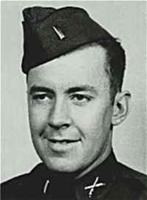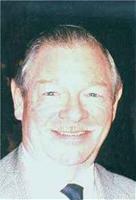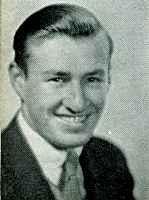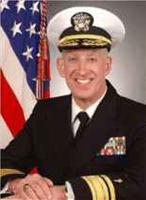2005 ROTC Hall of Fame Inductees
1st Lt. Daniel C. Kane Sr., Class of 1954

Daniel C. Kane was a 1954 graduate of St. Bonaventure University. He was a native of Olean, New York and a graduate of Olean High School.
He was enrolled in the Army Reserve Officer Training Corps (ROTC) program at St. Bonaventure and was commissioned his senior year (1951) to serve in Korea as a Field Artillery Officer. He obtained his degree after the war, when he was able to return and complete his area of study in Science.
He was trained as a Field Artillery Officer at Fort Sill, Oklahoma and was sent to Korea to serve in the 77
th Field Artillery, 1
st Cavalry Division. He served in A Battery and C Battery of the 77
th Field Artillery. Largely as the result of his being from a Catholic University, as a young, white officer, he was sent to a primarily black unit to serve as their leader.
The Army had only recently integrated and officers able to adapt to this fairly new aspect of the U.S. Army were chosen to serve in these positions. There was still a great deal of animosity, particularly among Southern soldiers and black soldiers. In Korea, he was attached to a Republic of Korea (ROK) unit and served primarily as a forward observer.
He went on to serve with distinction as a Forward Observer and junior officer during critical times in the fighting in Korea. His unit was recognized for bravery in a heated engagement with the North Koreans and Chinese, where a heavy artillery barrage was used to destroy a North Korean Tank Division offensive.
His unit was awarded citations for bravery in this engagement. During October through November of 1951, he was located on Hill 395 and was involved in a heated engagement with the enemy for surrounding hills where he called in artillery fires. From December 12-23, 1951, he was involved in a fierce battle between U.S. and ROK forces and the Chinese for Hill 37 and Hill 38.
Second Lieutenant Kane was located on Hill 38. One of the most notable engagements occurred on December 18, 1951 that lasted 13 hours. It was stated that the Chinese threw everything they had at his unit. Due to his duty position as Forward Observer, Second Lieutenant Kane was positioned ahead of his unit.
He was captured for a brief period of time during the attack as his position was overrun. His strong will and perseverance contributed to his successful escape and evasion from the enemy until he was able to rejoin his unit.
He was promoted to the rank of First Lieutenant and returned from Korea. He separated from the Army and continued on with a very successful and prosperous life in Corning, New York. Mr. Kane became a very active member in his community.
He served in numerous organizations to include the Holy Name Society, Boy Scouts of America, and as the Democratic City Chairman of Corning, New York. He was active in the Veterans of Foreign Wars and the American Legion where he served as a Commander and Post Commander.
The John P. Eaton Post dedicated a flagpole to his memory in 1971 in the City of Corning. Mr. Kane died on February 8, 1971 at the age of 43 in Atlanta, Georgia.
Capt. J. Willard Taylor, Class of 1956

Mr. J. Willard Taylor was born in Olean, New York January 31, 1935. As a young boy and into his teens, Mr. Taylor worked at his family’s manufacturing plant where he acquired and internalized skills that would benefit him during his years as an Army officer and later on as a successful businessman.
Upon graduating from Olean High School, he enrolled at St. Bonaventure University. Growing up during the years of World War II instilled a strong sense of patriotism and he was drawn to the Army Reserve Officer Training Corps (ROTC) program at the university.
As a cadet, Mr. Taylor also enlisted in the United States Army Reserve and was a member of a local anti-aircraft artillery unit.
Mr. Taylor received his commission and took his oath on January 31, 1957 as a Finance Officer. Lieutenant Taylor began his military career in a field that was implementing many new procedures and techniques.
He attended the United States Army Instructor Trainer Course at Hempstead, Long Island and completed the Finance Officer Basic Course in the newly organized Financial Management and Integrated Accounting program at Ft. Jay, Governor’s Island, New York.
As a young officer, he helped institute new procedures outlined at the Finance School for both the Post level and the First Army Comptroller level. He served as an Accounting Officer, Training Officer, and Company Commander; being promoted to Captain in 1965. He transferred to Inactive Reserve Status in 1967 and undertook new business opportunities in civilian life.
While pursuing his graduate studies in Secondary Education, Mr. Taylor became licensed in many areas to include insurance and real estate. He taught in the Buffalo area for a number of years and then moved on to his specialty, banking and investments. He served as a director of a National Bank for 13 years and also served as a regional director with the National Association of Investors.
J. Willard Taylor has been a driving force in forging a supportive and lasting relationship between the St. Bonaventure Army ROTC program and the American Legion. He has been a very active member of the Charles Harbel Post #892 in Allegany since the 1980s.
He served initially in an administrative capacity and then joined a committee as the ROTC Liaison Officer from Cattaraugus County to the 8
th District. This district encompasses the eight counties of western New York. Mr. Taylor has worked to energize the local posts to become involved with the ROTC programs to provide logistical support as well as improving the relationship between our veterans and our future officers.
He joined with those at the state level and is increasing the awareness of veteran’s benefits and affairs. Mr. Taylor is concerned for the well-being of our cadets in every way. One of the many examples is a program for our Color Guard in which he gains support from the local American Legion posts to purchase new jump boots for the cadets who participate in Color Guard.
His contributions, enthusiasm, and mentorship have been a cornerstone to the Army ROTC program’s success and it is greatly appreciated by the cadre and cadets.
Mr. Taylor is a retired private investor, continuing his formal education here at St. Bonaventure University and volunteering his time in local service organizations.
2004 ROTC Hall of Fame Inductees
 Maj. (Ret.) USAF William J. Casey, Class of 1941
Maj. (Ret.) USAF William J. Casey, Class of 1941
William J. Casey’s parents died when he was a boy and he was raised by his grandparents and his aunt in Shrewsbury and Rumson, New Jersey.
He graduated from Red Bank Catholic High School and enrolled at St. Bonaventure College, where he studied, gained a reputation as a boxer and earned a reputation as a prankster and a nickname that stuck: “Wild Bill.”
Graduating with a B.S. in Chemistry in 1941, Casey was commissioned a second lieutenant in the field artillery through the Army Reserve Officer Training Corps (ROTC) program. His uncle had taught him how to fly a Curtis “Jenny” Biplane when Casey was a young man and Casey was one of the first Bona men accepted as an Army Air Corps student in the summer of 1941.
He completed flight training school in February 1942 and earned his aviator’s wings.
In the midst of his training, the United States entered World War II and Casey’s first assignment was as a P38 fighter pilot in the Pacific Theater. In June 1942, while flying in the Battle of Midway, his two-engine fighter was hit by Japanese anti-aircraft fire and one engine was disabled.
The plane lost altitude and skipped across the waves until, having run out of fuel, Casey ditched in the Pacific Ocean. He eventually made contact with an American submarine and was returned to his unit. Soon after this, he was transferred to the Eighth Air Force in the European Theater of Operations and assigned as a B17 Flying Fortress pilot.
His comrades would remember that although he had switched to flying bombers, Casey continued to fly as if he was a fighter pilot.
Casey flew his first bomber missions in a 367th Bomb Squadron B17 named “Banshee” and on November 23, 1942, after delivering his ordnance on a German submarine base at St. Nazaire, France, a large formation of Focke-Wolfe 190 fighters attacked the American formation.
Diving in and firing at the Americans from as close as 50 feet, the German fighters damaged a number of planes, but Casey’s crew, during the ensuing hour-long battle, accomplished the extraordinary feat of shooting down seven German fighters in twelve minutes.
The citation for the Air Medal Casey received read that “his action undoubtedly saved his own crew and aided materially in the defense of the other planes in the flight.”
Several days later, while part of a 91st Bomb Group mission, Casey saw another American B17 trailing smoke and being harassed by enemy fighters. “Smoke and flames were spurting from [the plane] as Casey, abandoning ordinary flight procedure, wheeled his big ship around like a fighter, climbed over the low-flying Fortress, and flew above it” while the enemy attacked.
Having entered an aerial hornet’s nest, Casey protected the crippled plane as it returned safely to England, and the “Banshee” claimed two more enemy fighters. In recognition of his talent and bravery, Casey earned several Air Medals and for action on 27 February 1943, the Distinguished Flying Cross, as he continued to fly his B17.
On 17 April 1943, he was wounded when his Flying Fortress was shot down over Bremen, Germany. Having ejected from the plane, he was subsequently taken prisoner and eventually held near Dachau. In April 1945, Casey escaped from the camp and joining with other Americans, acquired a German ambulance which he drove through enemy lines to freedom at a British air base. The War in Europe ended while he convalesced.
Casey remained in the United States Air Force until retiring as a major in 1960. He married and had a son. He earned a doctorate in political science and as a Fulbright Fellow studied in El Salvador for 18 months. He taught at the University of Florida and at St. Leo College before retiring from teaching and passed away on 17 March 1988.
Rear Adm. Rev. Louis V. Iasiello, O.F.M., Class of 1972

Louis V. Iasiello grew up in Staten Island, New York and graduated from St. Bonaventure University with a BA in History in 1972.
He went on to earn an M.S. in Education from Niagara University in 1973, and that same year entered the Order of Friars Minor (Franciscans) and began his preparation for solemn vows and ministry. He was awarded a Masters of Divinity from the Washington Theological Union in 1977 and following ordination to the diaconate, he ministered in Anapolis, Brazil.
After his ordination to the priesthood, he was assigned to a Franciscan parish in a Hispanic community in the Bronx and then became chairperson of the Modern Languages Department at Bishop Timon High School in Buffalo, New York.
Iasiello was commissioned as a Navy Chaplain Lieutenant (Junior Grade) in the Naval Reserves in 1981, and in July 1983, he was recalled to active duty.
His active duty assignments include: Naval Air Station, Memphis; U.S. Coast Guard, Kodiak, Alaska; USS Ranger (CV-61) during Operation Earnest Will in the Iran-Iraq War and other deployments to Korea and the Persian Gulf; Second Marine Division; (8th Marine Regiment, 2nd Marine Regiment, 26th Marine Expeditionary Unit, Special Operations Capable [MEU SOC] and Marine Forces Panama (including two deployments to Norway, Operation Just Cause, Panama, and deployments to the Mediterranean.)
A Distinguished Military Graduate of Command and Staff Naval War College in 1990, Father Louis Iasiello has served as Assistant Fleet Chaplain, U.S. Atlantic Fleet and Deputy Chaplain, U. S. Atlantic Command; Staff Chaplain Joint Task Force JTF-160 (with deployments to Cuba and Haiti); Director for Operational Ministry, Atlantic Fleet, and Director, Naval Chaplains School.
After his selection to flag rank, he became the first chaplain flag officer to hold both the positions of Deputy Chief of Navy Chaplains and Chaplain of the United States Marine Corps.
He also has served as a representative to the Presbyteral Council of the Archdiocese for the Military Services, USA, since 1994, as a member of the Board of Trustees of Saint Bonaventure University since September 2000 and as a member of the Board of Directors of the Navy-Marine Corps Relief Society since 2003.
In 2003, Father Louis earned his Ph.D. from Salve Regina University, writing a highly respected dissertation entitled
Jus In Bello: Key Issues for a Contemporary Assessment of Just Behavior in War.
Father Louis is currently the twenty-third Chief of Navy Chaplains, and the highest ranking graduate of St. Bonaventure currently serving on active duty. His personal decorations include the Legion of Merit (Gold Star in lieu of two awards), the Defense Meritorious Service Medal, the Meritorious Service Medal (three awards); Navy/Marine Corps Commendation Medal (two awards), Coast Guard Commendation Medal; Navy/Marine Corps Achievement Medal; the Combat Action Ribbon; and numerous other unit and service citations and awards.